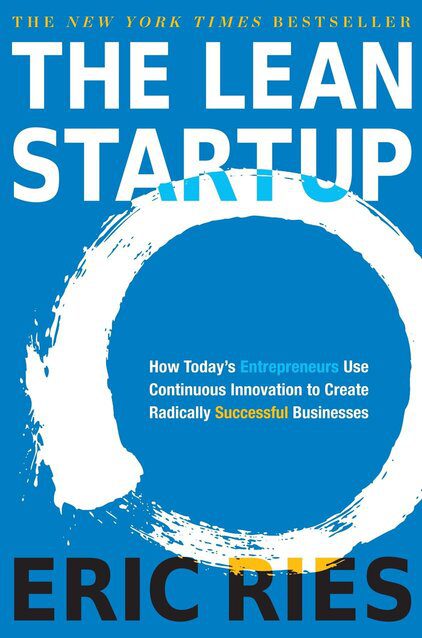Lean Startup: the application of lean thinking to the process of innovation.
In The Lean Startup: How Today’s Entrepreneurs Use Continuous Innovation to Create Radically Successful Businesses, Entrepreneur and Author Eric Ries proposes a methodology for developing businesses and products that aims to shorten product development cycles and rapidly discover if a proposed business model is viable; this is achieved by adopting a combination of business-hypothesis-driven experimentation, iterative product releases, and validated learning.
Inspired by lessons from lean manufacturing. Lean Startup relies on “validated learning,” rapid scientific experimentation, as well as a number of counter-intuitive practices that shorten product development cycles, measure actual progress without resorting to vanity metrics, and learn what customers really want.
The book is divided into three parts: “Vision,” “Steer,” and “Accelerate.”
- Vision makes the case for a new discipline of entrepreneurial management.
- Steer dives into the Lean Startup method in detail, showing one major turn through the core Build-Measure-Learn feedback loop.
- Accelerate, explore techniques that enable Lean Startups to speed through the Build-Measure-Learn feedback loop as quickly as possible, even as they scale.
THE LEAN STARTUP METHOD
The five principles of the Lean Startup, which inform all three parts of the book, are as follows:
1. Entrepreneurs are everywhere.
You don’t have to work in a garage to be in a startup. The concept of entrepreneurship includes anyone who works within my definition of a startup: a human institution designed to create new products and services under conditions of extreme uncertainty. That means entrepreneurs are everywhere and the Lean Startup approach can work in any size company, even a very large enterprise, in any sector or industry.
2. Entrepreneurship is management.
A startup is an institution, not just a product, and so it requires a new kind of management specifically geared to its context of extreme uncertainty. Entrepreneur should be considered a job title in all modern companies that depend on innovation for their future growth.
3. Validated learning.
Startups exist not just to make stuff, make money, or even serve customers. They exist to learn how to build a sustainable business. This learning can be validated scientifically by running frequent experiments that allow entrepreneurs to test each element of their vision.
4. Build-Measure-Learn.
The fundamental activity of a startup is to turn ideas into products, measure how customers respond, and then learn whether to pivot or persevere. All successful startup processes should be geared to accelerate that feedback loop.
5. Innovation accounting.
To improve entrepreneurial outcomes and hold innovators accountable, we need to focus on the boring stuff: how to measure progress, how to set up milestones, and how to prioritize work. This requires a new kind of accounting designed for startups—and the people who hold them accountable.
THE ROOTS OF THE LEAN STARTUP
The Lean Startup takes its name from the lean manufacturing revolution that Taiichi Ohno and Shigeo Shingo are credited with developing at Toyota. Lean thinking is radically altering the way supply chains and production systems are run. Among its tenets are drawing on the knowledge and creativity of individual workers, the shrinking of batch sizes, just-in-time production and inventory control, and an acceleration of cycle times. It taught the world the difference between value-creating activities and waste and showed how to build quality into products from the inside out.
The Lean Startup adapts these ideas to the context of entrepreneurship, proposing that entrepreneurs judge their progress differently from the way other kinds of ventures do. Progress in manufacturing is measured by the production of high-quality physical goods.
The goal of a startup is to figure out the right thing to build—the thing customers want and will pay for—as quickly as possible. In other words, the Lean Startup is a new way of looking at the development of innovative new products that emphasizes fast iteration and customer insight, a huge vision, and great ambition, all at the same time.
What’s a Startup
“The Lean Startup is a set of practices for helping entrepreneurs increase their odds of building a successful startup.”
A startup is a human institution designed to create a new product or service under conditions of extreme uncertainty. Anyone who is creating a new product or business under conditions of extreme uncertainty is an entrepreneur whether he or she knows it or not and whether working in a government agency, a venture-backed company, a nonprofit, or a decidedly for-profit company with financial investors.
Validated Learning
Validated learning is not after-the-fact rationalization or a good story designed to hide failure. It is a rigorous method for demonstrating progress when one is embedded in the soil of extreme uncertainty in which startups grow. Validated learning is the process of demonstrating empirically that a team has discovered valuable truths about a startup’s present and future business prospects. It is more concrete, more accurate, and faster than market forecasting or classical business planning. It is the principal antidote to the lethal problem of achieving failure: successfully executing a plan that leads nowhere.
VALUE VS. WASTE
Lean thinking defines value as providing benefit to the customer; anything else is waste. In a manufacturing business, customers don’t care how the product is assembled, only that it works correctly. But in a startup, who the customer is and what the customer might find valuable are unknown, part of the very uncertainty that is an essential part of the definition of a startup.
Innovation Accounting
The Lean Startup method builds capital-efficient companies because it allows startups to recognize that it’s time to pivot sooner, creating less waste of time and money. Although we write the feedback loop as Build-Measure-Learn because the activities happen in that order, our planning really works in the reverse order:
We figure out what we need to learn, use innovation accounting to figure out what we need to measure to know if we are gaining validated learning, and then figure out what product we need to build to run that experiment and get that measurement. All of the techniques in Part Two are designed to minimize the total time through the Build-Measure-Learn feedback loop.
The Minimum Viable Product
A minimum viable product (MVP) helps entrepreneurs start the process of learning as quickly as possible. It is not necessarily the smallest product imaginable, though; it is simply the fastest way to get through the Build-Measure-Learn feedback loop with the minimum amount of effort.
Contrary to traditional product development, which usually involves a long, thoughtful incubation period and strives for product perfection, the goal of the MVP is to begin the process of learning, not end it. Unlike a prototype or concept test, an MVP is designed not just to answer product design or technical questions. Its goal is to test fundamental business hypotheses.
The goal of the MVP is to test fundamental business hypotheses.
Pivot
A pivot is a “structured course correction designed to test a new fundamental hypothesis about the product, strategy, and engine of growth.
Build-Measure-Learn
The Build–Measure–Learn loop emphasizes speed as a critical ingredient to customer development. A team or company’s effectiveness is determined by its ability to ideate, quickly build a minimum viable product of that idea, measure its effectiveness in the market, and learn from that experiment.
All the Best in your quest to get Better. Don’t Settle: Live with Passion.



1 Comment
Pingback: 100 Books Reading Challenge 2021 – Lanre Dahunsi